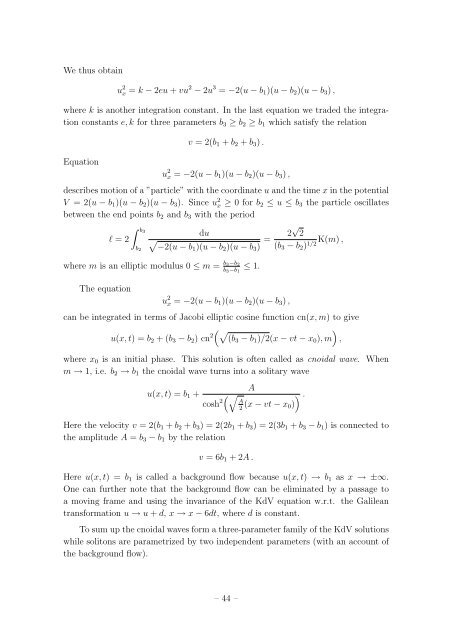Student Seminar: Classical and Quantum Integrable Systems
Student Seminar: Classical and Quantum Integrable Systems
Student Seminar: Classical and Quantum Integrable Systems
You also want an ePaper? Increase the reach of your titles
YUMPU automatically turns print PDFs into web optimized ePapers that Google loves.
We thus obtain<br />
u 2 x = k − 2eu + vu 2 − 2u 3 = −2(u − b 1 )(u − b 2 )(u − b 3 ) ,<br />
where k is another integration constant. In the last equation we traded the integration<br />
constants e, k for three parameters b 3 ≥ b 2 ≥ b 1 which satisfy the relation<br />
Equation<br />
v = 2(b 1 + b 2 + b 3 ) .<br />
u 2 x = −2(u − b 1 )(u − b 2 )(u − b 3 ) ,<br />
describes motion of a ”particle” with the coordinate u <strong>and</strong> the time x in the potential<br />
V = 2(u − b 1 )(u − b 2 )(u − b 3 ). Since u 2 x ≥ 0 for b 2 ≤ u ≤ b 3 the particle oscillates<br />
between the end points b 2 <strong>and</strong> b 3 with the period<br />
l = 2<br />
∫ b3<br />
b 2<br />
du<br />
√<br />
−2(u − b1 )(u − b 2 )(u − b 3 ) = 2 √ 2<br />
K(m) ,<br />
(b 3 − b 2 )<br />
1/2<br />
where m is an elliptic modulus 0 ≤ m = b 3−b 2<br />
b 3 −b 1<br />
≤ 1.<br />
The equation<br />
u 2 x = −2(u − b 1 )(u − b 2 )(u − b 3 ) ,<br />
can be integrated in terms of Jacobi elliptic cosine function cn(x, m) to give<br />
(√ )<br />
u(x, t) = b 2 + (b 3 − b 2 ) cn 2 (b3 − b 1 )/2(x − vt − x 0 ), m ,<br />
where x 0 is an initial phase. This solution is often called as cnoidal wave. When<br />
m → 1, i.e. b 2 → b 1 the cnoidal wave turns into a solitary wave<br />
u(x, t) = b 1 +<br />
A<br />
(√ ) .<br />
cosh 2 A<br />
(x − vt − x 2 0)<br />
Here the velocity v = 2(b 1 + b 2 + b 3 ) = 2(2b 1 + b 3 ) = 2(3b 1 + b 3 − b 1 ) is connected to<br />
the amplitude A = b 3 − b 1 by the relation<br />
v = 6b 1 + 2A .<br />
Here u(x, t) = b 1 is called a background flow because u(x, t) → b 1 as x → ±∞.<br />
One can further note that the background flow can be eliminated by a passage to<br />
a moving frame <strong>and</strong> using the invariance of the KdV equation w.r.t. the Galilean<br />
transformation u → u + d, x → x − 6dt, where d is constant.<br />
To sum up the cnoidal waves form a three-parameter family of the KdV solutions<br />
while solitons are parametrized by two independent parameters (with an account of<br />
the background flow).<br />
– 44 –

















